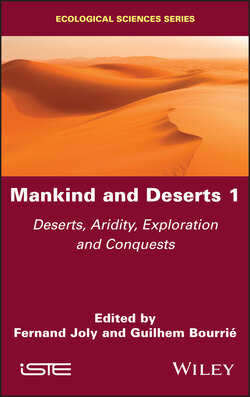Mankind and Deserts 1

Реклама. ООО «ЛитРес», ИНН: 7719571260.
Оглавление
Группа авторов. Mankind and Deserts 1
Table of Contents
Guide
List of Illustrations
List of Tables
Pages
Mankind and Deserts 1. Deserts, Aridity, Exploration and Conquests
Foreword. Mankind and deserts
Acknowledgments
1. Introduction: The Concept of a Desert
1.1. All about a word
1.2. Arriving at a definition. 1.2.1.What is a desert?
1.2.2.Conceptual deserts: deserts that have been experienced
1.3. The world of deserts
1.4. Deserts of the world
1.5. To know more
2. Conquering Deserts
2.1. Prehistoric times
2.2. The dawn of history
2.2.1.The Near and Middle East – Sahara
2.2.2.Central and East Asia
2.2.3.America
2.2.4.Southern Africa – Australia
2.3. Knowledge of deserts in prehistory
2.4. Antiquity. 2.4.1.The Near East – Sahara
2.4.2.The Middle East
2.4.2.1. The Far East
2.5. Deserts known to Antiquity
2.6. Deserts as corridors of migration
2.7. Deserts: the birthplace of religions
2.7.1.Polytheistic religions. 2.7.1.1. Egypt
2.7.1.2. Mesopotamia, Persia and Central Asia
2.7.2.Buddhism
2.7.3.Judaism
2.7.4.Christianity
2.7.5.Islam
2.8. Deserts and empires in the Middle Ages
2.8.1.The Arabs. 2.8.1.1. The Abbasid Caliphate
2.8.1.2. The Arab order
2.8.2.The Turks
2.8.2.1. The Seljuk Empire
2.8.2.2. The Crusades
2.8.3.The Mongols
2.8.3.1. Genghis Khan
2.8.3.2. The Mongol Empire
2.8.3.3. Timur Leng and the end of Mongol domination
2.9. Deserts known at the end of the Middle Ages
2.9.1.Travelers and merchants
2.9.2.Medieval geography of deserts. 2.9.2.1. Asia and the Silk Road
2.9.2.2. Africa and the roads for the salt, gold and slave trade
2.9.2.3. The representation of deserts
2.10. To be continued …
2.11. References. General opus
Prehistory
Antiquity
Middle Ages
Travellers and merchants
Ancient Texts
3. Aridity. 3.1. Where we examine semantics
3.2. Causes of aridity
3.2.1.Meteorological causes
3.2.1.1. Solar radiation
3.2.1.2. Humidity in air
3.2.1.3. Rising air and subsidence
3.2.1.4. Hadley cells
3.2.1.5. Seasonal variations in the intertropical system
3.2.1.6. Atmospheric circulation in the Southern Hemisphere
3.2.1.7. The unique case of the Indian Ocean
3.2.2.Geographic causes
3.2.2.1. Continentality
3.2.2.2. The unique features of ocean margins
3.2.2.3. The dynamic role of relief features
3.2.2.4. Edaphic aridity
3.2.3.Human causes
3.3. Climatic factors and the numerical expression of aridity
3.3.1.Precipitation
3.3.1.1. The difficulty of measuring rainfall in the desert
3.3.1.2. The quantity of rainfall
3.3.1.3. Seasonal distribution patterns
The first group includes stations where the maximum rainfall occurs in summer
The final group of stations, which are among the most arid, comprises stations where the rainfall pattern is random
3.3.1.4. Concentration and variability
3.3.2.Temperatures
3.3.2.1. Seasonal variations
3.3.3.Evaporation
3.3.4.Aridity indices
3.3.4.1. Indices that consider precipitation and temperature
3.3.4.2. Formulae that consider precipitation and evaporation
3.3.4.3. Formulae that consider bioclimatic data
3.4. Nuances in aridity
3.4.1.Phytogeographic criteria
3.4.2.Hydrological criteria
3.4.3.Geomorphological criteria
3.4.4.Soil use criteria
3.4.5.Sub-desert aridity
3.4.6.Desert aridity
3.4.7.Hyperaridity
3.4.8.Conclusion
3.5. Variations in climatic aridity over time
3.5.1.Variations on a geological scale
3.5.1.1. Means of studying deserts
3.5.1.2. The deserts of the past
Paleozoic
The Mesozoic Era
The Cenozoic Era
3.5.2.Climatic changes and deserts in the Quaternary period
3.5.2.1. Knowledge of deserts of the Quaternary period
3.5.2.2. Pluvials and interpluvials
3.5.3.Variations on a historic scale – droughts. 3.5.3.1. The concept of drought
3.5.3.2. Significant droughts
3.5.3.3. The great drought in the Sahel (the late 20th Century)
3.5.3.4. Droughts, climate crises and climate change
3.6. Unusual phenomena caused by or promoted by aridity
3.7. Aridity and drought
3.8. References
List of Authors
Index. A, B
C
D, E
F, G
H, I
K, L
M, N
P
R, S
T, U
V, W, X
WILEY END USER LICENSE AGREEMENT
Отрывок из книги
Series Editor
.....
Figure 1.1. Arid regions around the world as per (Meigs 1977–1979), modified
How can it be that, in the age of air travel, widespread tourism, television and the Internet, we still so often have such a fuzzy, conventional and mythical image of the deserts? There has certainly been progress in gaining direct knowledge of the deserts, but this knowledge itself has spread very slowly and imperfectly to non-desert regions. The difficulties around entering and traveling through the desert can be blamed for this slow dissemination, as well as the risks inherent to these regions. Man has traveled across the deserts for centuries out of necessity and as a result of certain events (military, political or economic), rather than through a desire to discover or gain knowledge. The merchants and travelers would follow linear paths marked by water points. They would rarely deviate from these paths, for fear of losing themselves and dying in the desert. Modern automobiles (not counting those used in the rallies) can cover in one hour the distance that a camel would take a day to travel. Those who make these journeys today do so at a speed that allows them to grasp only the most superficial of information. Views from planes or satellite images are always difficult to decipher. Tourists, reporters and artists, who are very demanding, prefer the picturesque or sensational over banal reality. There is an increasing number of scientists in this field, but they have a very limited audience. For all of these reasons, the image that the public receives of the desert is partial and varies widely depending on the source. The varying levels of reliability of the information and the unequal distribution of this knowledge go a great way toward explaining the obscurity, mystery and legends that deserts are veiled in even today.
.....